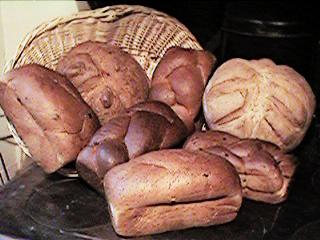
Yeast Baking Tips

1. When using instant yeast, the yeast gets mixed with the dry ingredients. The water called for in the recipe will be added with the other liquids, at a temperature of 115º to 120º. Breads made with instant yeast will rise faster than those made with regular yeast.
2. When using regular yeast, add it to the water called for in the recipe (warmed to 110º) & 1 Tbsp of the sugar called for. Let it proof (form bubbles).
3. Initial kneading: When the dough is sufficiently kneaded it will spring back when you indent it with your fingers.
4. To test if dough has risen enough after the first rising, push 2 fingers about 1/2" into the dough. If the holes remain, the dough is ready.
5. Press or roll out all air bubbles after each rising.
6. Right before baking: The dough should feel light & airy when touched lightly.
7. For a hard crust, put a pan half filled with water on the bottom rack of your oven. French bread is considered a hard crust bread.
8. For soft rolls, snuggle them close together in a greased pie or cake pan. Let rise until doubled in volume.
9. Listen!! When the bread has baked enough it will sound hollow when tapped on the bottom.
10. Internal temperature of finished bread should be 195º.
11. When cooling a regular loaf of bread, lay it on its side on a cooling rack. Braided breads cool flat on the cooling rack.
12. As soon as you remove the bread or rolls from the oven, you may put canned shortening (Crisco) or softened butter on a paper towel & gently rub over the crust. This will keep the crust soft.
13. A bread or serrated knife is best for slicing bread.
